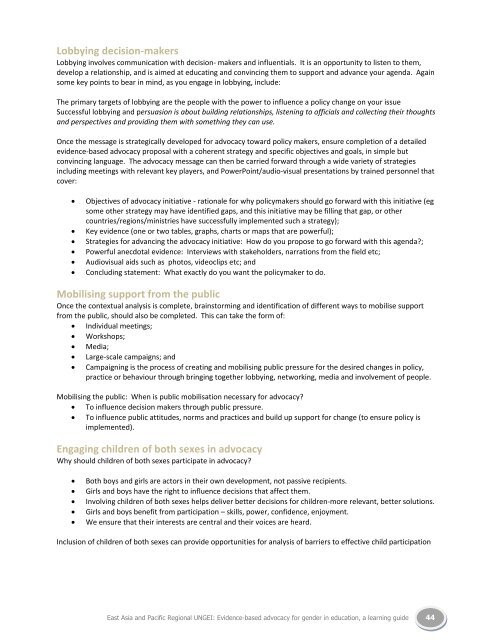Evidence-Based Advocacy - United Nations Girls' Education Initiative
Evidence-Based Advocacy - United Nations Girls' Education Initiative
Evidence-Based Advocacy - United Nations Girls' Education Initiative
Create successful ePaper yourself
Turn your PDF publications into a flip-book with our unique Google optimized e-Paper software.
Lobbying decision-makers<br />
Lobbying involves communication with decision- makers and influentials. It is an opportunity to listen to them,<br />
develop a relationship, and is aimed at educating and convincing them to support and advance your agenda. Again<br />
some key points to bear in mind, as you engage in lobbying, include:<br />
The primary targets of lobbying are the people with the power to influence a policy change on your issue<br />
Successful lobbying and persuasion is about building relationships, listening to officials and collecting their thoughts<br />
and perspectives and providing them with something they can use.<br />
Once the message is strategically developed for advocacy toward policy makers, ensure completion of a detailed<br />
evidence-based advocacy proposal with a coherent strategy and specific objectives and goals, in simple but<br />
convincing language. The advocacy message can then be carried forward through a wide variety of strategies<br />
including meetings with relevant key players, and PowerPoint/audio-visual presentations by trained personnel that<br />
cover:<br />
<br />
<br />
<br />
<br />
<br />
<br />
Objectives of advocacy initiative - rationale for why policymakers should go forward with this initiative (eg<br />
some other strategy may have identified gaps, and this initiative may be filling that gap, or other<br />
countries/regions/ministries have successfully implemented such a strategy);<br />
Key evidence (one or two tables, graphs, charts or maps that are powerful);<br />
Strategies for advancing the advocacy initiative: How do you propose to go forward with this agenda?;<br />
Powerful anecdotal evidence: Interviews with stakeholders, narrations from the field etc;<br />
Audiovisual aids such as photos, videoclips etc; and<br />
Concluding statement: What exactly do you want the policymaker to do.<br />
Mobilising support from the public<br />
Once the contextual analysis is complete, brainstorming and identification of different ways to mobilise support<br />
from the public, should also be completed. This can take the form of:<br />
Individual meetings;<br />
Workshops;<br />
Media;<br />
Large-scale campaigns; and<br />
Campaigning is the process of creating and mobilising public pressure for the desired changes in policy,<br />
practice or behaviour through bringing together lobbying, networking, media and involvement of people.<br />
Mobilising the public: When is public mobilisation necessary for advocacy?<br />
To influence decision makers through public pressure.<br />
To influence public attitudes, norms and practices and build up support for change (to ensure policy is<br />
implemented).<br />
Engaging children of both sexes in advocacy<br />
Why should children of both sexes participate in advocacy?<br />
<br />
<br />
<br />
<br />
<br />
Both boys and girls are actors in their own development, not passive recipients.<br />
Girls and boys have the right to influence decisions that affect them.<br />
Involving children of both sexes helps deliver better decisions for children-more relevant, better solutions.<br />
Girls and boys benefit from participation – skills, power, confidence, enjoyment.<br />
We ensure that their interests are central and their voices are heard.<br />
Inclusion of children of both sexes can provide opportunities for analysis of barriers to effective child participation<br />
East Asia and Pacific Regional UNGEI: <strong>Evidence</strong>-based advocacy for gender in education, a learning guide 44

















